
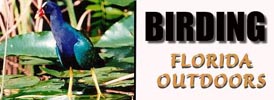
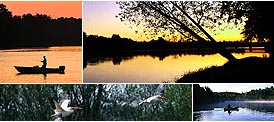
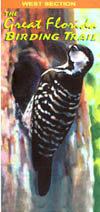
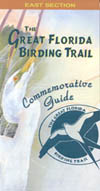
BIRDS
American Flamingos
American Flamingo an extremely slim rose-pink wading bird as tall as a Great Blue Heron but much more slender. Note the sharply bent bill or broken "Roman nose." Feeds with the bill or head immersed. In flight it shows much black in the wings; its extremely long neck is extended droopily in front and the long legs trail behind, giving the impression that the bird might easily fly backward as forward. Pale washed-out birds may be escapes from zoos as the color often fades under captive conditions. Immatures are also much paler than normal adults.
They often perch on snags over water with wings spread to dry their feathers. The nickname "snakebird" comes from their ability to swim submerged with only their head and neck visible. They dive to spear fish with their long, sharp bills, often tossing the catch in the air and swallowing it headfirst.
Anhingas build platform nests in trees, preferably clusters of willows, or reuse a heron or egret nest. Parental tasks are shared. They usually nest in colonies which may include herons and egrets.
Bald Eagle
Eagles build huge nests in tall trees and often return to the same nest year after year. After breeding, in late May or June, most migrate north and return in August. Golden Eagles are occasional visitors to Florida in nonsummer months.
Brown Pelican
Brown Pelicans nest in colonies, usually on mangrove islands although breeding has been reported at Lake Okeechobee.
Although the Brown Pelican has made significant strides from population lows in the 1960's and 1970's when some states' populations were virtually wiped out by pesticide contamination, it remains a species of special concern. In addition to habitat loss, fishing hooks and line cause many injuries and fatalities.
The nest of the Clapper Rail is built in the higher areas of tidal salt marshes or in tall cordgrass to prevent inundation during high tides. It is constructed of a platform of marsh grasses, and the surrounding vegetation is arched over the nest to form a protective canopy. The cup of the nest is well defined and formed of grass and other fine plant materials. They are capable of flight at 63 to 70 days. Two broods may be raised each season.
Florida Burrowing Owl
If there are Burrowing Owls nearby, you can attract them to nest by providing a sandy area one to two feet in diameter and placing a T-perch near it. The spot should be in an unobstructed area that doesn't flood.
Great Blue Heron
Great White Heron
Great and Snowy Egrets
Great and Snowy Egrets usually forage in shallow water but may also forage in fields. Reddish Egrets may put on quite a show while foraging. They sometimes spread their wings, creating shaded areas on the water to attract fish. Usually they run through the water, head tilted to the side, leaping sideways and suddenly changing direction. Snowy Egret are all species of special concern due to low populations numbers.
Ibis
Both forage in water, in sand and muddy bottoms, and on the ground. They forage and roost in flocks. They nest in large colonies surrounded by water, often with egrets and herons. The White Ibis are species of special concern due to losses of foraging and nesting habitat.
Limpkins
Limpkins are a species of special concern. While having made a comeback after hunting seriously reduced the population, Limpkins' dependence on the apple snail remains problematic.
Osprey
Ospreys nest near or over water in the tops of tall trees, including cypress and pine, and in mangroves along the coasts. They also nest on manmade structures such as telephone poles, television antennas, channel markers, and nesting platforms. The same nest may be reused and expanded for many years. They hunt by hovering high above the water and plunging with talons extended to catch fish. Short spines on the undersides of their toes help them grasp fish. Ospreys suffered serious population declines in the 1950's and 1960's, the result of pesticide contamination, breeding site destruction, and shooting. They have recovered though there has been a decline in the Keys population, hence their status as a species of special concern in Monroe County.
Pileated Woodpecker
All except the Pileated will use nest boxes. Male forehead and "mustache" red. Female forehead and "mustache" black. Flight reveals white underwing linings contrasting with black flight feathers. Prefers to nest in mesic areas, close to streams; selects stands with greatest basal area, greatest density of stems, and highest crown canopy. Typically roost in hollow trees with multiple entrances.
Roseate Spoonbills
When flying in flocks, the birds generally form a diagonal line. The head and neck are always outstretched. The wing beat is slow and long.
The spoonbills were once hunted in large numbers. Stories are told of a single days harvest of two men equaling 200-300 birds. The wings were used as fashionable fans. Tragically, most birds were hunted at the peak of nesting season.
Royal Terns
Royal Terns breed at great densities, therefore, a large Royal Tern colony is highly conspicuous. However, colonies are not always large. Food is primarily fish and shrimp. Seasonal Occurrence. Royal Terns occur along the full coast of Florida; occasionally they are found inland around large lakes, September through April. Egg sets have been collected April through July.
Turkey Vulture
White Pelicans
White Pelicans winter in Everglades National Park. These beautiful creatures begin their long migration to their summer breeding grounds in early April, to freshwater lakes in the interior U.S. and Canada. Before leaving, breeding adults develop a horny plate or knob on their bills, believed to be a target for other adults when they arrive at their communal breeding grounds and fight for territories. It's possible these targets leave the breeders undamaged--otherwise fights among adults could tear their gular pouches and injure them for life. Once the eggs are laid, the horny bill plates fall off.
Whooping Cranes
Large, bulky nests are usually built over water or on floating vegetation. Usually two eggs are laid. After about 30 days of incubation, the eggs hatch, and within 24 hours, the young leave the nest to follow their parents. They will be able to fly within 2.5 months but won't be on their own until they're about 10 months old.
Sandhill Cranes may feed on cracked corn scattered on the ground. Peanuts may also be taken as they feed on peanut crops.
In 1942, the total Whooping Crane population had been reduced to 22 birds. In 1995, there were 267 -- 133 wild birds that migrate from the Northwest Territories to Texas, 100 in captive-breeding facilities, and 34 in experimental introduced populations. The latest report of a Whooping Crane in Florida was in 1936.
In 1993, 14 young captive-reared Whooping Cranes were released in the Three Lakes Wildlife Management Area in Osceola County. By 1995, another 38 had been released. By the end of that year, 24 birds had survived. (Predation by bobcats accounted for most of the deaths.) Continued releases are planned in hopes of establishing a breeding population of 25 or more breeding pairs.
Wild Turkey
Wood Storks
They forage in flocks in fairly calm, shallow water with little aquatic vegetation. They build large, bulky nests of sticks in sites surrounded by water. Large colonies nest together. Nests may be built so close together that they're almost touching. They usually nest in cypress trees and mangroves. When water levels are too high, making foraging less efficient, nestlings are less likely to survive and fewer birds nest. Similar problems occur when water levels fall too low.
Wood stork populations in southern Florida have been declining for the past 60 years because of widespread habitat damage, particularly the drainage of wetlands. About the same time that nesting rates in Florida were hitting an all-time low, nests were discovered in Georgia and South Carolina. Although the wood stork's status has stabilized, the quality of wintering habitats in south Florida may yet prevent the wood stork's recovery.
![]()
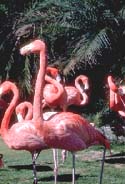 Pinkish white to vermilion wading birds with extremely long necks and legs. The thick bill is bent sharply down and lined with numerous lamellae for straining food, small mollusks, Crustaceans, Blue-green algae
Pinkish white to vermilion wading birds with extremely long necks and legs. The thick bill is bent sharply down and lined with numerous lamellae for straining food, small mollusks, Crustaceans, Blue-green algae
![]()
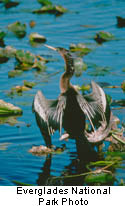 Anhingas
Anhingas
Anhingas inhabit quiet bodies of freshwater and, while found statewide, are much more numerous in central and south Florida.
![]()
 In 1782, the Bald Eagle was chosen as the national emblem, beating out the Wild Turkey by one vote. As a result of habitat loss and poisoning by pesticides and heavy metals, there were less than 3000 Bald Eagles in the continental U.S. in 1982. Thanks to conservation measures, the population is increasing. There are now more than 3000 Bald Eagles in Florida.
In 1782, the Bald Eagle was chosen as the national emblem, beating out the Wild Turkey by one vote. As a result of habitat loss and poisoning by pesticides and heavy metals, there were less than 3000 Bald Eagles in the continental U.S. in 1982. Thanks to conservation measures, the population is increasing. There are now more than 3000 Bald Eagles in Florida.
![]()
 The Brown Pelican is most frequently seen along the coasts of the peninsula. It is also a resident of the panhandle, but less common during the winter. They are increasingly seen at large inland lakes.
It forages by soaring over the water and diving. It also waits at fishing piers and boat docks for handouts.
The Brown Pelican is most frequently seen along the coasts of the peninsula. It is also a resident of the panhandle, but less common during the winter. They are increasingly seen at large inland lakes.
It forages by soaring over the water and diving. It also waits at fishing piers and boat docks for handouts.
![]()
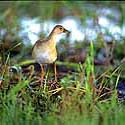 Clapper Rails
Clapper Rails
Clapper Rails, also known as Marsh Hens and Mud Hens, are more often heard than seen. The Clapper Rail is found throughout Florida's coastal marshes and mangrove swamps. During periods of low tide, Clapper Rails venture onto exposed mudflats to hunt for insects, small crabs, and mollusks (Longstreet 1969). This habit makes the Clapper Rail possibly the most visible member of the rails.
![]()
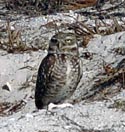 The Florida Burrowing Owl is a species of special concern. It is found in dry prairie habitats in the peninsula and Keys as well as pastures, airports, golf courses, and in partially developed areas. It nests in a burrow, usually one it excavates. Data is being collected in South Florida.
The Florida Burrowing Owl is a species of special concern. It is found in dry prairie habitats in the peninsula and Keys as well as pastures, airports, golf courses, and in partially developed areas. It nests in a burrow, usually one it excavates. Data is being collected in South Florida.
![]()
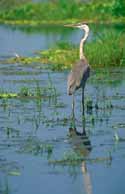 The Herons are all found in both fresh and saltwater habitats where they hunt by standing still and stabbing prey. Some consider the Great White to be a white morph of the Great Blue. Great Blue Herons often nest in tall trees. The Herons are threatened by the draining of wetlands.
The Herons are all found in both fresh and saltwater habitats where they hunt by standing still and stabbing prey. Some consider the Great White to be a white morph of the Great Blue. Great Blue Herons often nest in tall trees. The Herons are threatened by the draining of wetlands.
The Herons are all found in both fresh and saltwater habitats where they hunt by standing still and stabbing prey. Some consider the Great White to be a white morph of the Great Blue. The Herons are threatened by the draining of wetlands. Great White Herons often nest in tall trees.
![]()
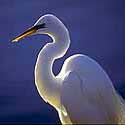 Great and Snowy Egrets inhabit both fresh- and saltwater areas, while Reddish Egrets are found in areas with brackish or saltwater, usually coastal islands. All usually nest in shrubs.
Great and Snowy Egrets inhabit both fresh- and saltwater areas, while Reddish Egrets are found in areas with brackish or saltwater, usually coastal islands. All usually nest in shrubs.
![]()
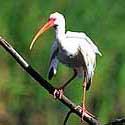 Glossy and White Ibises are found in inland marshes and wet prairies. White Ibises also inhabit swamps and coastal areas. Their young, however, must have freshwater.
Glossy and White Ibises are found in inland marshes and wet prairies. White Ibises also inhabit swamps and coastal areas. Their young, however, must have freshwater.
![]()
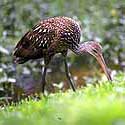 Limpkins are found in freshwater marshes and swamps and along lakes, streams, and rivers where apple snails are common.
Limpkin nests have been found in treetops, shrubs, tall grasses, and on floating vegetation. Breeding sites may be abandoned if the food supply runs low or if there is human disturbance.
Limpkins are found in freshwater marshes and swamps and along lakes, streams, and rivers where apple snails are common.
Limpkin nests have been found in treetops, shrubs, tall grasses, and on floating vegetation. Breeding sites may be abandoned if the food supply runs low or if there is human disturbance.
![]()
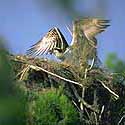 Ospreys are found along lakes, rivers, and coasts with relatively clear water. They are found statewide, but in greater numbers in some areas such as the Kissimmee and St. Johns River basins, the swamps of Alachua and Marion counties, and near Sebring and Lake Placid. Fewer are found in north Florida during the winter.
Ospreys are found along lakes, rivers, and coasts with relatively clear water. They are found statewide, but in greater numbers in some areas such as the Kissimmee and St. Johns River basins, the swamps of Alachua and Marion counties, and near Sebring and Lake Placid. Fewer are found in north Florida during the winter.
![]()
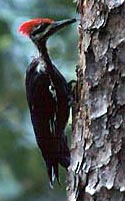 All the woodpeckers will visit feeders for seeds, nuts, fruit, and suet.
This woodpecker feeds on insects, primarily carpenter ants and woodboring beetle larvae; also wild fruits and nuts. It pries off long slivers of wood to expose ant galleries. The Pileated Woodpecker uses its long, extensible, pointed tongue with barbs and sticky saliva to catch and extract ants from tunnels.
All the woodpeckers will visit feeders for seeds, nuts, fruit, and suet.
This woodpecker feeds on insects, primarily carpenter ants and woodboring beetle larvae; also wild fruits and nuts. It pries off long slivers of wood to expose ant galleries. The Pileated Woodpecker uses its long, extensible, pointed tongue with barbs and sticky saliva to catch and extract ants from tunnels.
![]()
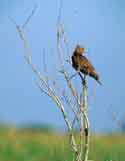 Red-shouldered Hawks
Red-shouldered Hawks
Red-shouldered Hawks inhabit swamps and woodlands. Nests are built in tall deciduous trees and often reused. After raising the young, they may use the nest as a feeding platform. Red-shouldered hawks are usualy found along river valleys and moist lowland woods. They compete with red-tailed hawks for nesting sites, and this may explain some of their distribution pattern, as they may be forced into closed canopy woods that the red-tailed hawk does not use. This hawk will feed on a variety of prey, primarily small rodents, amphibians, and reptiles. Red-shouldered hawks are common but more frequently heard than seen. They like areas near streams.
![]()
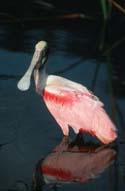 Spoonbills nest in dense mangrove forest areas. Generally found on isolated islands of Florida Bay nesting in December, January, and February. It is one sign of spring to have the spoonbills return from nesting area. Here, there are about two dozen bachelors that do not migrate or nest. The nests are deeply hollowed with 3-5 dull white eggs with spots.
Food: Roseates use their spooned beak by weaving or waving from side to side through the water. Sensitive nerve endings allow the bird to feel when the beak comes in contact with food and it shuts its strainer. They munch on small fish, shellfish, insects, and shrimp and other amphipods. They have been known to feed in both salt and fresh water. Roseate maintain their pink color through the foods they eat.
Spoonbills nest in dense mangrove forest areas. Generally found on isolated islands of Florida Bay nesting in December, January, and February. It is one sign of spring to have the spoonbills return from nesting area. Here, there are about two dozen bachelors that do not migrate or nest. The nests are deeply hollowed with 3-5 dull white eggs with spots.
Food: Roseates use their spooned beak by weaving or waving from side to side through the water. Sensitive nerve endings allow the bird to feel when the beak comes in contact with food and it shuts its strainer. They munch on small fish, shellfish, insects, and shrimp and other amphipods. They have been known to feed in both salt and fresh water. Roseate maintain their pink color through the foods they eat.
![]()
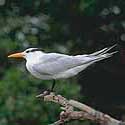 The Royal Tern is almost entirely restricted to salt water, where it frequents harbors, estuaries, sandy beaches, and nearshore waters on the coast. However, it is now being seen more frequently, especially in winter, over inland lakes and at phosphate mines in Florida. Royal Terns breed on the North American coasts from southern California and Maryland south to northern South America.
The Royal Tern is almost entirely restricted to salt water, where it frequents harbors, estuaries, sandy beaches, and nearshore waters on the coast. However, it is now being seen more frequently, especially in winter, over inland lakes and at phosphate mines in Florida. Royal Terns breed on the North American coasts from southern California and Maryland south to northern South America.
![]()
 Vultures, sometimes mistakenly called "buzzards", feed primarily on carrion. They will also eat garbage and decaying vegetation. Turkey Vultures do occasionally prey on birds and small animals.
They have no feathers on their heads. Adult Turkey Vultures' red heads resemble turkey wattles, hence the name. Unlike most birds, they have a keen sense of smell which they use to locate food.
Vultures roost and nest communally. They don't build nests but lay their eggs in a sheltered location, often in a dense thicket or hollow stump.
There is currently a research project tracking the movement of tagged vultures.
Vultures, sometimes mistakenly called "buzzards", feed primarily on carrion. They will also eat garbage and decaying vegetation. Turkey Vultures do occasionally prey on birds and small animals.
They have no feathers on their heads. Adult Turkey Vultures' red heads resemble turkey wattles, hence the name. Unlike most birds, they have a keen sense of smell which they use to locate food.
Vultures roost and nest communally. They don't build nests but lay their eggs in a sheltered location, often in a dense thicket or hollow stump.
There is currently a research project tracking the movement of tagged vultures.
![]()
 Since White Pelicans weigh between 10 - 13 lbs. and have the second greatest wingspan of any bird in North America (9 - 9 1/2 feet), it's hard to believe these monstrosities can soar with the grace of flying ballerinas. Their flights are often highly synchronized. Often flies in V formation or wheels high in the sky on midday thermasl; does not dive from the air like Brown Pelican. Rest on sandbars not in trees.
Since White Pelicans weigh between 10 - 13 lbs. and have the second greatest wingspan of any bird in North America (9 - 9 1/2 feet), it's hard to believe these monstrosities can soar with the grace of flying ballerinas. Their flights are often highly synchronized. Often flies in V formation or wheels high in the sky on midday thermasl; does not dive from the air like Brown Pelican. Rest on sandbars not in trees.
![]()
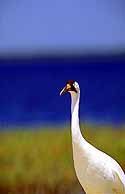 Sandhill Cranes are found in inland shallow freshwater marshes, prairies, pastures, farmlands, and lawns. Florida has both resident and migratory populations. The Florida subspecies is slightly smaller and darker than the visiting birds. Many of the migratory birds winter at Paynes Prairie.
Sandhill Cranes are found in inland shallow freshwater marshes, prairies, pastures, farmlands, and lawns. Florida has both resident and migratory populations. The Florida subspecies is slightly smaller and darker than the visiting birds. Many of the migratory birds winter at Paynes Prairie.
![]()
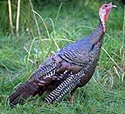 Wild Turkeys forage on the ground during the day and roost in trees at night. They are most active around dawn and dusk. They nest on the ground.
Wild Turkeys are usually found in or near wooded areas and swamps. They are most common down the center of the state from Orlando to Lake Okeechobee.
The Northern Bobwhite, or Quail, is usually not found in heavily developed areas. It is a ground nester and needs the heavy cover of tall grasses, brambles, dense hedges, or brush piles. It will forage for seeds under feeders.
Wild Turkeys forage on the ground during the day and roost in trees at night. They are most active around dawn and dusk. They nest on the ground.
Wild Turkeys are usually found in or near wooded areas and swamps. They are most common down the center of the state from Orlando to Lake Okeechobee.
The Northern Bobwhite, or Quail, is usually not found in heavily developed areas. It is a ground nester and needs the heavy cover of tall grasses, brambles, dense hedges, or brush piles. It will forage for seeds under feeders.
![]()
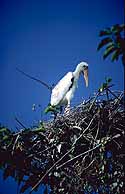 The wood stork is all white except for its short black tail and black feathers that punctuate the end of its wings. Graceful from afar, the wood stork up close reveals a featherless head and an imposing beak. The wood Storks, most common in central and south Florida, are found in wetland areas.
The wood stork is all white except for its short black tail and black feathers that punctuate the end of its wings. Graceful from afar, the wood stork up close reveals a featherless head and an imposing beak. The wood Storks, most common in central and south Florida, are found in wetland areas.
![]()












